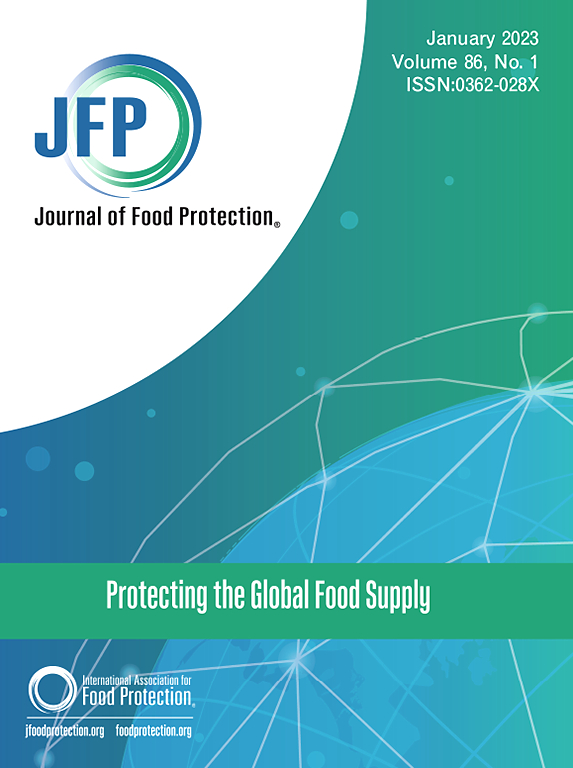土鸡中 Infantis 沙门氏菌生长预测模型的开发与验证
IF 2.1
4区 农林科学
Q3 BIOTECHNOLOGY & APPLIED MICROBIOLOGY
引用次数: 0
摘要
大多数零售火鸡肉样品(25 克)不含沙门氏菌或沙门氏菌含量较低。然而,零售后滥用温度会导致沙门氏菌在包装中扩散和生长。此外,它还可能导致沙门氏菌含量达到引发沙门氏菌病的严重风险。尤其是当血清型为顶级人类临床分离菌(如 Infantis)时,情况更是如此。因此,当前的研究旨在开发和验证一个预测模型,用于预测因凡蒂斯沙门氏菌在受到温度滥用的土火鸡中的生长情况。其目的是填补这一病原体和食品组合风险评估中血清型特异性数据和模型的空白。在 16 至 40 摄氏度的条件下进行了 0 至 28 小时的贮藏试验,对带有本地微生物菌群的商用土火鸡样品(0.2 克)进行了低初始接种量(0.85 log10)的 Infantis 沙门氏菌贮藏试验。MPN 数据被拟合到一个三相线性一级模型中。针对一级模型参数开发了二级模型,并将其用于一级模型,以创建三级模型,预测土火鸡中因凡蒂斯沙门氏菌的生长与时间和温度的关系。使用验证软件工具中的测试数据、模型性能和可接受预测区方法的模型验证标准对数据和三级模型预测进行了评估。当部分和完全可接受预测区(pAPZ)内的残差(观测值-预测值)比例≥ 0.7 时,三级模型预测的偏差和准确度被认为是可接受的。对于从属数据(n = 406),三级模型的总体 pAPZ 为 0.866;对于用于内插的独立数据(n = 177),三级模型的总体 pAPZ 为 0.853。然而,由于存在局部预测问题,验证预测范围被限制在 16 至 40 摄氏度条件下 0 至 8 小时的区域内。尽管如此,这个验证范围足以模拟消费者在家中备餐时火鸡肉的温度滥用情况。因此,该模型填补了沙门氏菌和土火鸡风险评估中的一个重要数据和建模空白。还需要更多的数据来修复和充分验证该模型。本文章由计算机程序翻译,如有差异,请以英文原文为准。
Development and Validation of a Predictive Model for Growth of Salmonella Infantis in Ground Turkey
Most retail samples (25 g) of ground turkey contain no or low levels of Salmonella. However, temperature abuse after retail can lead to spread and growth of Salmonella in the package. In addition, it can lead to levels that pose a significant risk of salmonellosis. This is especially true when the serotype is a top human clinical isolate, like Infantis. Therefore, the current study was undertaken to develop and validate a predictive model for the growth of Salmonella Infantis in ground turkey subjected to temperature abuse. The purpose was to fill a gap for serotype-specific data and models in risk assessments for this pathogen and food combination. Storage trials with a low initial inoculum (0.85 log10) of Salmonella Infantis in commercial ground turkey samples (0.2 g) with native microflora were conducted at 16–40 °C for 0–28 h. Salmonella was enumerated in ground turkey samples using an automated, whole sample enrichment, miniature, most probable number (MPN) assay. The MPN data were fitted to a three-phase linear primary model. Secondary models for primary model parameters were developed and used in the primary model to create a tertiary model that predicted the growth of Salmonella Infantis in ground turkey as a function of time and temperature. Data and tertiary model predictions were evaluated using the test data, model performance, and model validation criteria of the Acceptable Prediction Zones method in the Validation Software Tool. The tertiary model predictions were considered to have acceptable bias and accuracy when the proportion of residuals (observed − predicted) in the partly and fully acceptable prediction zones (pAPZ) was ≥0.7. The overall pAPZ of the tertiary model was 0.866 for dependent data (n = 406) and 0.853 for independent data for interpolation (n = 177). However, there were local prediction problems that limited the validated prediction range to a region from 0 to 8 h at 16–40 °C. Nonetheless, this validation range was sufficient to simulate temperature abuse of ground turkey during meal preparation in the consumers’ home. Thus, the model fills an important data and modeling gap in risk assessments for Salmonella and ground turkey. Additional data are needed to repair and fully validate the model.
求助全文
通过发布文献求助,成功后即可免费获取论文全文。
去求助
来源期刊

Journal of food protection
工程技术-生物工程与应用微生物
CiteScore
4.20
自引率
5.00%
发文量
296
审稿时长
2.5 months
期刊介绍:
The Journal of Food Protection® (JFP) is an international, monthly scientific journal in the English language published by the International Association for Food Protection (IAFP). JFP publishes research and review articles on all aspects of food protection and safety. Major emphases of JFP are placed on studies dealing with:
Tracking, detecting (including traditional, molecular, and real-time), inactivating, and controlling food-related hazards, including microorganisms (including antibiotic resistance), microbial (mycotoxins, seafood toxins) and non-microbial toxins (heavy metals, pesticides, veterinary drug residues, migrants from food packaging, and processing contaminants), allergens and pests (insects, rodents) in human food, pet food and animal feed throughout the food chain;
Microbiological food quality and traditional/novel methods to assay microbiological food quality;
Prevention of food-related hazards and food spoilage through food preservatives and thermal/non-thermal processes, including process validation;
Food fermentations and food-related probiotics;
Safe food handling practices during pre-harvest, harvest, post-harvest, distribution and consumption, including food safety education for retailers, foodservice, and consumers;
Risk assessments for food-related hazards;
Economic impact of food-related hazards, foodborne illness, food loss, food spoilage, and adulterated foods;
Food fraud, food authentication, food defense, and foodborne disease outbreak investigations.
 求助内容:
求助内容: 应助结果提醒方式:
应助结果提醒方式:


